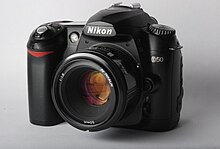Nikon D50
 |
|
| Overview | |
|---|---|
| Type | Digital single-lens reflex |
| Lens | |
| Lens | Interchangeable Nikon F-mount |
| Sensor/Medium | |
| Sensor | CCD |
| Maximum resolution | 3,008 × 2,000 (6.1 effective megapixels) |
| ASA/ISO range | ISO 200–1600 in 1 EV steps (1/3 or 1/2 EV steps using Auto ISO control) |
| Recording medium | SD memory card |
| Focusing | |
| Focus modes | Manual, Single shot AF, Continuous AF, Automatic AF Selection (AF operation subject to lens compatibility) |
| Focus areas | 5 zone selectable: single area, dynamic area, closest subject |
| Exposure/Metering | |
| Exposure modes | Automatic, Portrait, Landscape, Child, Sport, Closeup, Night Portrait, Manual, Aperture Priority, Shutter Priority, Programmed Auto |
| Exposure metering | TTL full-aperture exposure metering system |
| Metering modes | Spot, Center Weighted, Matrix |
| Flash | |
| Flash | Built-in TTL Speedlight with hotshoe |
| Flash bracketing | +1/−3 EV in 1/3 or 1/2 steps |
| Shutter | |
| Shutter | Electromechanical vertical-travel focal-plane type |
| Shutter speed range | 1/4000 to 30 seconds, bulb; 1/500 flash X-sync |
| Continuous shooting | 2.5 frame/s, up to 12 shots (JPEG) or 4 shots (NEF) |
| Viewfinder | |
| Viewfinder | Optical TTL |
| Image Processing | |
| Custom WB | Automatic, Incandescent, Fluorescent, Direct Sunlight, Flash, Cloudy, Shade, Preset (Custom) |
| General | |
| Rear LCD monitor | 2.0 in (51 mm), 130,000 dot TFT |
| Battery | Nikon EN-EL3 family |
| Optional battery packs | Nikon EN-EL3a and EN-EL3e |
| Weight | 544 g (1.199 lb) body only; 616 g (1.358 lb) with EN-EL3 battery; 826 g (1.821 lb) with battery and AF-S DX ZOOM - NIKKOR 1 8 - 5 5 mm f/3.5-5.6 GED kit lens |
| Made in | Thailand |
The D50 is a 6.1-megapixel entry-level digital single-lens reflex camera, sold from June 2005 until November 2006 by Nikon. It was Nikon's first DSLR aimed at the consumer market, and sold for US$899. It uses the Nikon F mount. The D50 was succeeded by the Nikon D40 in November 2006.
It has a 23.7 mm by 15.6 mm DX format image sensor with 6.1 million effective pixels. It also has a 2.0" (50 mm) polysilicon TFT LCD with 130,000 pixels. The camera uses a through-the-lens full-aperture exposure metering system. It can simultaneously record NEF and JPEG data to a Secure Digital storage device. Like its newer, higher-end sibling (the D80), the D50 uses Secure Digital instead of CompactFlash cards found on previous Nikon digital SLRs. The camera is powered by a rechargeable lithium-ion battery which is claimed to be able to take up to 2,000 shots on a single charge. The camera is compatible with PictBridge printers and can shoot 2.5 frames per second in continuous mode. The camera's dimensions are 133 mm in width, 102 mm in height, and 76 mm in depth.
The D50 is the only entry-level Nikon DSLR to have the autofocus motor ('screw drive') built into the camera body, making the camera backwards-compatible with mechanical-drive autofocus lenses (Nikkor AF series) dating back to 1989. This feature has been eliminated on later entry-level models and is currently only available on mid-range and advanced models. This makes the D50 the lightest Nikon DSLR to have the autofocus motor.
This camera has many settings that can only be accessed by selecting a detailed menu view. One such feature is the ability to a make series of differently-exposed images for processing into HDRI photographs. The camera menu refers to this setting as BKT (Bracketed Set).
...
Wikipedia
